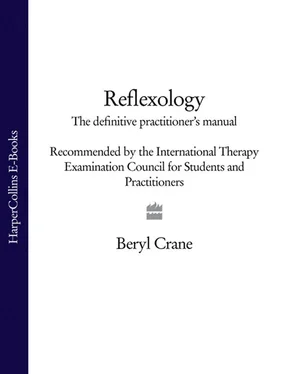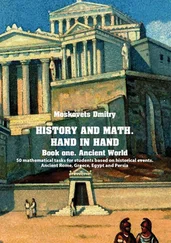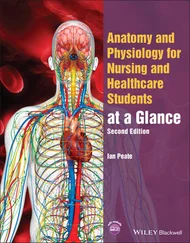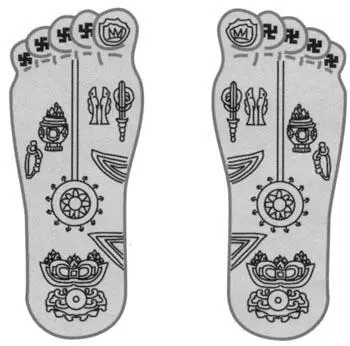
Figure 1.3 Buddha’s foot, showing the Sun sign on the toes, possibly indicating Qi.
Good health depends on the correct balance between these two opposites, the negative and positive. To follow the general principles of Yin and Yang one needs also to be aware of the environment and the changes of the season; all of the above had to be taken into consideration to preserve life. Today China is known for its many centenarians, and longevity is something all Chinese people cherish; many feel that it can be attained through correct living and the use of TCM principles.
The Zang-fu organs and the meridians
TCM theory divides the body into 12 organ systems, 6 of which are Yang (Fu or hollow organs): Stomach, Small Intestine, Large Intestine, Bladder, Gall Bladder and Triple Burner (or Triple Heater or Triple Energizer), and 6 of which are Yin (Zang or solid organs): Heart, Liver, Spleen (and Pancreas), Lungs, Kidneys and Pericardium. Together they are called the Zang-fu.
Each of the Zang organs is related to one of the Fu organs. So there are six pairs. Often when treating a patient, these Yin and Yang organs can be coupled together because they are so closely related, and treatment of one will often affect the other. The pairs are: the Liver and Gall Bladder, the Spleen and Stomach, the Lungs and Large Intestine, the Kidneys and Bladder, the Heart and Small Intestine, and the Pericardium and Triple Burner. The Triple Burner (Sanjiao) regulates the functioning of all the Zang-fu organs; it also acts as a passageway for the movement of all fluids.
The organs are also designated according to the Five Elements theory. According to ancient Chinese traditions, the elements comprise Wood, Fire, Earth, Metal and Water. These elements are thought to influence each other, in a cyclical manner.
The balance of Yin and Yang within each of the above organ systems is regulated and influenced by the Yin-Yang balance of the Qi flowing through the meridians connected with them. This Qi is particularly easy to influence for the purposes of treatment at particular points called acupuncture points (or acupoints). Acupoints at the extremities (hands and feet) are thought to be the most powerful to use ( see figure 1.9).
There are 12 major meridians in the body and limbs, each connected to one organ system; 6 connect the hands with the face or chest, and 6 connect the feet with the face or chest. These meridians are often classified in three ways:
1. According to their cycle of energy. This is as follows: Lungs, Large Intestine, Stomach, Spleen, Heart, Small Intestine, Bladder, Kidneys, Pericardium, Triple Burner, Gall Bladder, Liver. The cycle of energy goes: hands-hands, feet-feet, hands-hands, feet-feet, hands-hands, feet-feet; we can balance the energy by working on this theory.
2. According to the division of the two groups into Yin and Yang: the Yin meridians of the feet and legs are: the Liver, Spleen and Kidneys – these ascend from the feet to the breast ( figure 1.4) the Yin meridians of the hands and arms are: Lungs, Heart, Pericardium – these descend from the breast to terminate in the fingers ( figure 1.5) the Yang meridians of the hands and arms are: Large Intestine, Small Intestine and Triple Burner – these ascend from the fingers to the face ( figure 1.6) the Yang meridians of the feet and legs are: the Stomach, Bladder, Gall Bladder – these descend from the face to the toes ( figure 1.7).
3. According to where they are located: the six meridians on the hands and arms include the Lungs, Large Intestine, Pericardium, Triple Burner, Heart and Small Intestine. The six meridians on the feet and legs are the Kidneys, Spleen, Liver, Stomach, Gall Bladder and Bladder.
There is an involved association between an organ and a meridian. They are often paired together because of the anatomical closeness of the corresponding meridian, which links the Yin and the Yang organ. In reflexology this opposite point becomes an area of assistance to work.
We begin to see a combination between the groups as follows:
• The three Yin meridians descend from the breast area to the hands ( see figure 1.5); that is the Lungs, Heart and Pericardium, (for details of each meridian pathway see figures 2.8–2.20).
• The three Yang meridians of the hands ascend from the hand to the face ( see figure 1.6) that is the Large Intestine, Small Intestine and Triple Burner.
• The three Yin meridians of the feet ascend from the feet to breast area ( see figure 1.4); that is the Spleen, Kidneys and Liver.
• The three Yang meridians of the feet descend from the face to the feet ( see figure 1.7); that is the Stomach, Bladder and Gall Bladder.

Figure 1.4 The three ascending Yin meridians of the feet (Spleen, Liver and Kidneys)
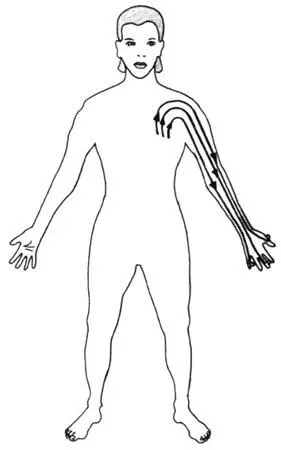
Figure 1.5 The three descending Yin meridians of the hands (Lungs, Heart and Pericardium)
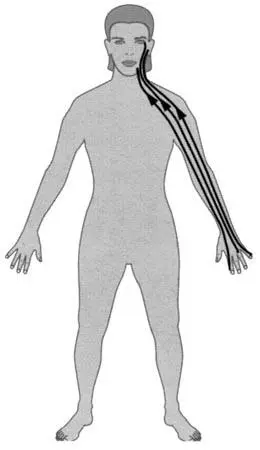
Figure 1.6 The three ascending Yang meridians of the hands (Large Intestine, Triple Burner and Small Intestine)
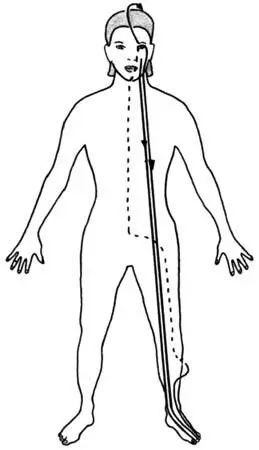
Figure 1.7 The three descending Yang meridians of the feet (Stomach, Bladder and Gall Bladder)
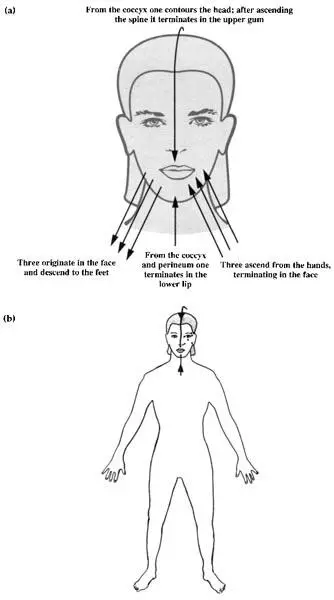
Figure 1.8 (a) Eight major meridians converge on the face. (b) The face has three originating points, three terminating points, and two terminating points from the vessels.
There are many interactions between the organs and meridians, and they are paired in many ways. Some old doctrines link the Yin organs in a cycle, and then the Yang organs, in a theory that attempts to describe the movement of Qi energy. One idea is that there is an area of the body where Qi undergoes a fundamental change in polarity, where Yin is converted into Yang or vice versa ( figure 1.9). One speculation is that at such an area or point the therapist gets a much more positive result, because the energy is unstable and nearer to the surface here. However, there are areas which contain the points where the ascending Yang meridians terminate on the face and where the descending Yang meridians originate from prior to descending to the feet: these are thought to be more stable yet not so potent. Yet if this is so, why is it that these facial distal points are so powerful? It is important to note that there are eight major meridians converging on the facial area ( see figures 1.8a and 1.8b, and chapter 7). Is this why the ears, head and facial points are so effective? This interchange of energies takes place on the fingers of the upper limbs as the Yin energy is near its end, and the Yang energy is about to commence; this fluctuation extends from the fingers to the elbow. So we see the three Yin meridians conveying their energy to the three Yang meridians, anywhere in this area. This leads to the traditional pairing of these organs on the hand:
Читать дальше
